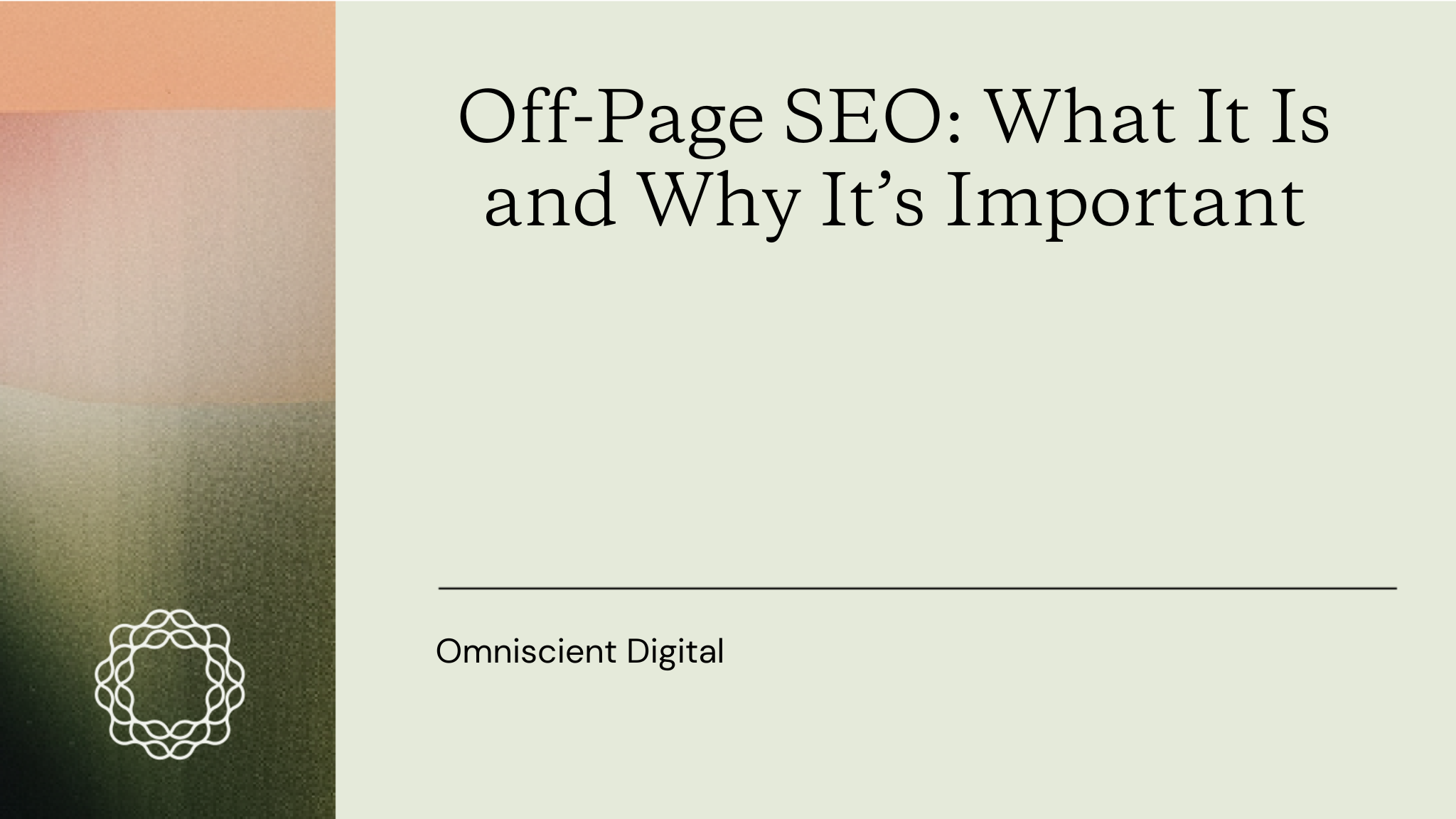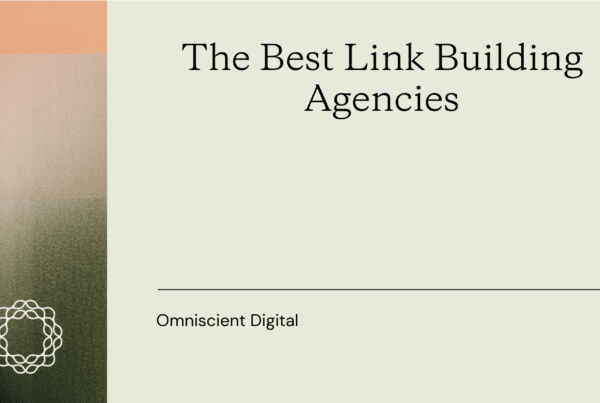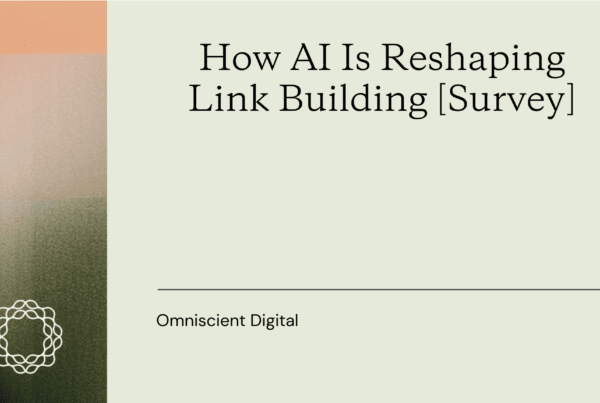
SEO is a two-fold game: On-page SEO sets the foundation, and off-page SEO is where the real battle begins.
On-page SEO is like doing well enough at tryouts to earn a uniform. Fail, and you won’t even make the bench. But off-page SEO? That’s what gets you time on the field—running plays with your team, securing a spot as a starter, and getting noticed by your coach and the fans.
If you’re managing a SaaS content engine that needs to convert traffic into pipeline, off-page SEO is how you show up in key conversations and high-authority roundups your ICP actually reads. To make it work, you have to do more than collect backlinks like participation trophies. You need to become a reliable authority in your category. A source people cite and search engines trust.
Get off-page SEO right, and your organic growth compounds. More visibility. More branded search. More referral traffic. But to do that, you need to know what modern off-page SEO looks like, how to build a strategy that goes beyond outdated link building tactics, and how to turn that strategy into long-term growth.
The building blocks of off-page SEO
Off-page SEO is much more than link building. While backlinks are an important ranking signal, they’re only one part of the broader ecosystem that makes your website authoritative in the eyes of both people and search engines.
That ecosystem is built on brand perception—how others think about you, reference you, and engage with you across social media, blogs, podcasts, communities, and review sites. These signals from across the web contribute to your perceived trust and relevance.
When they’re consistent and positive, they reinforce your on-page SEO efforts by boosting your domain authority and improving your chances of ranking for competitive terms. It’s like Google saying, “Everyone seems to think you’re legit. Maybe we should, too.”
This is especially true for SaaS companies. Nailing the building blocks of off-page SEO drives lasting organic growth. It leads to long-term visibility, compound brand equity, and a pipeline that doesn’t rely solely on paid ads or cold outreach.
Why high-quality backlinks matter for off-page SEO
Backlinks still carry serious weight in SEO. In fact, when it comes to off-page SEO, techniques like article submission, guest posting, social bookmarking, and directory submissions play a crucial role, with backlinks remaining one of the most important ranking signals.
But not all backlinks deliver the same value. One mention on TechCrunch or an industry thought leader’s blog is worth more than a hundred random links from sketchy directories in a language your audience doesn’t speak.

Search engines evaluate backlinks with the nuance of a seasoned wine critic. They care about relevance, context, and the authority of the referring domain. If your profile looks like it was built with a Fiverr coupon and zero editorial discretion, it’s probably doing you more harm than good.
Earning links from trusted, relevant sites in your niche is a different story:
- Greater trust and brand credibility: People trust endorsements. When respected publications and industry blogs mention your site, that social proof gets passed along to you.
- More organic traffic: Links from credible sources don’t just impress Google. They drive qualified referral traffic from audiences who are ready to convert.
- Higher domain authority (DA) and domain rating (DR): DA and DR are essentially your website’s credit score. Strong links improve that score, boosting your authority and ability to rank for competitive keywords.
- Stronger competitive advantage: SEO is a zero-sum game. A solid backlink strategy can help you leapfrog legacy brands that have grown complacent.
Building a strong backlink profile isn’t about mass-producing mediocre content and begging strangers to link to it. It’s about earning links by creating genuinely useful, link-worthy assets—and understanding how to pitch it, distribute it, and position it strategically within your broader playbook.
White-hat vs. black-hat link building: What you need to know
Link building works. But how you build your links makes all the difference.
White-hat link building strategies follow Google’s guidelines and build long-term authority by earning backlinks through value, not shortcuts. These include:
- Writing guest posts for reputable websites
- Creating linkable assets like infographics, original research, and guides
- Running digital PR campaigns that earn citations from high-authority publications
- Building relationships with bloggers, journalists, and influencers
White-hat link building drives organic traffic, strengthens your site’s authority, and improves your search engine results page (SERP) rankings over time.
Black-hat tactics, on the other hand, attempt to manipulate rankings with practices like:
- Buying backlinks
- Participating in link schemes
- Overusing exact-match anchor text
- Spamming directories or posting low-value comments on forums
Link farms, Private Blog Networks (PBNs), and shady schemes might offer short-term gains, but they’re a minefield for long-term damage, especially as Google’s algorithms get smarter at sniffing them out.
If you’re building a brand for the long haul, white-hat strategies are the only game worth playing.
How to earn high-quality backlinks
Earning high-quality backlinks isn’t about chasing vanity numbers. It’s about building a backlink profile that search engines respect and your target audience actually clicks.
Here are four strategies that work in practice:
- Write guest posts for high-authority blogs. Contribute valuable content to niche-relevant sites with good reputations. And don’t just write fluff. Offer original insights, data-backed perspectives, and contextual links that enhance the user experience.
For example, if you’re a project management SaaS company, write a post for HubSpot on “Remote Work Productivity Tools.” Include a relevant link to your software within the post that provides value to the reader.
- Replace broken backlinks with your content. Use tools like Ahrefs or Semrush to find broken links on relevant websites. Then reach out to the site owner and suggest your content as a replacement. This approach is helpful, efficient, and a great way to kick off influencer marketing or blogger outreach relationships.
- Create linkable assets. Develop content people reference and want to share, such as original research, detailed SEO checklists, infographics, or beginner’s guides and deep dives. Promote these assets through targeted outreach, pitching them to digital marketers, content marketers, and industry influencers. As Gary Vee says: “Content is king, but marketing is queen and runs the household.”
- Run digital PR campaigns. Use newsworthy data, unique stories, or intriguing press releases to land features in top-tier publications like Forbes or Wired.
For instance, let’s say you’re Plaid and you drop a data-packed report on “How AI Is Transforming Finance.” Pitch it to journalists, land features on major sites, and boom—authoritative backlinks that signal trust and relevance.
These aren’t just link building tactics. They’re brand-building plays. When executed consistently, they improve your visibility, boost your domain authority, and build long-term SEO equity.
Why off-page SEO is essential for SaaS businesses
In SaaS, on-page SEO is the cost of entry. Off-page SEO is what builds the moat.
Your brand’s online reputation—how you’re mentioned in forums, on social media, in online reviews, and on Google My Business—influences everything from search engine ranking to conversions.

Off-page SEO is where SaaS brands can punch above their weight. It’s not just a checkbox in your search engine optimization plan. When done right, it’s how you turn Google from a stranger into your top-performing sales rep.
Boost domain authority and outrank competitors
Want to compete in a red-ocean SaaS category? You need more than strong content on your site. You need high-quality backlinks pointing to it.
When authoritative websites link to your thought leadership, it sends a crystal-clear signal to Google Search: “This brand knows its stuff.”
Drive organic user acquisition without paying for every click
Customer acquisition through paid ads is all well and good if you’ve got infinite runway. But if you’re a growth marketer thinking in quarters—not burn rate—you’ll want to build organic traffic that sticks around and scales.
Smart link building strategies, consistent social media engagement, and high-impact content marketing bring you traffic that’s both qualified and cost-effective.
Build trust from awareness and watch it convert
Traffic alone isn’t the goal. Qualified traffic that converts is. Guest features and influencer partnerships help you reach your ICP where they’re already paying attention, while your content positions you as the obvious choice when they’re ready to buy.
When paired with off-page signals like third-party endorsements, reviews, and brand mentions, these efforts keep your audience engaged long after the first click. Get your strategy right, and your conversion rates won’t just improve, they’ll become repeatable.
Measuring off-page SEO success: Tracking what actually matters
Off-page SEO doesn’t deliver overnight wins. It compounds over time. To know if your strategy is working (and not just creating noise), you need to measure the right metrics. Not vanity counts or raw backlink numbers, but KPIs that prove real growth in search visibility, authority, and organic traffic.
Domain authority and domain rating
Moz gives you DA, and Ahrefs gives you DR, but assess the strength of your backlink profile based on link quality, referring domains, and relevance. If your numbers are climbing, consider it a green light on your link building strategies.
Organic traffic growth
This one’s obvious but essential. Use Google Analytics to monitor how your organic traffic grows over time, and tie it back to campaigns like:
- Digital PR drops
- Guest blogging
- Influencer marketing
- Major content shares on social media platforms
The goal isn’t just more users, it’s attracting target audiences who actually engage and convert.
Backlink quality and quantity
Forget about raw link count, focus on:
- High-quality backlinks from relevant websites
- Contextual, editorial anchor text
- Backlinks that actually drive referral traffic
Track your progress with tools like Semrush or Majestic, and make sure you’re building a clean, reputable off-page SEO profile, not collecting toxic links from spammy sites.
Referring domains
A healthy backlink profile isn’t just deep—it’s wide. Focus on earning links from a diverse set of authoritative websites. A dozen links from one domain ≠ a dozen domains that each link once. Google sees breadth as a signal of trust and authority.
Brand mentions
Even without a hyperlink, brand mentions in press releases, blog posts, or forums still build credibility. They strengthen E-E-A-T (Experience, Expertise, Authoritativeness, Trustworthiness) signals and help you show up consistently in SERPs.
Social shares and engagement
When your content gets amplified across social media, it doesn’t just increase awareness. It attracts bloggers, journalists, and content marketers who might link to you.
Track social media engagement through platforms like BuzzSumo, LinkedIn analytics, and even X (Twitter). The more reach your content marketing has, the more link opportunities come knocking.
These KPIs aren’t just numbers. They’re proof that your off-page SEO efforts are gaining traction where it matters: visibility, authority, and long-term growth.
Off-page SEO best practices for SaaS marketers
A sloppy approach to link building is a waste of everyone’s time. Instead, invest in deliberate systems, mutually beneficial relationships, and content marketing plays that deliver long-term SEO value.
Conduct competitive backlink analysis
Want to know where to start? Spy on what’s already working for your competitors. Use tools like Ahrefs, Semrush, or Moz to:
- Analyze competitor backlink profiles
- Identify referring domains you haven’t earned yet
- Spot patterns in anchor text, linkable assets, and citation sources
This isn’t copying. It’s reverse-engineering their off-page SEO tactics so you can do it better.
Build relationships with industry partners and thought leaders
The best backlinks aren’t bought. They’re earned through connection and collaboration with:
- Influencers in your niche
- Content marketers at complementary companies
- Bloggers, journalists, and SEO agencies
Co-create content, exchange guest posts, or host joint webinars. Good relationships not only generate high-quality backlinks but also boost your brand mentions across relevant sites and social platforms.
Create high-value, shareable content
If your content doesn’t deserve the links, no strategy will save you. Focus on:
- Publishing data-backed industry reports
- Creating actionable how-to guides, SEO checklists, and infographics
- Developing tools, templates, or calculators your audience can’t live without
Linkable assets earn natural backlinks and get cited in articles, forums, and directories—without you having to ask. But if you do pair them with strategic outreach, you’ll start building links that compound your domain authority.
Optimize social media engagement
Social platforms aren’t just for clicks. They’re discovery engines. Shares, comments, and reposts on LinkedIn, X (Twitter), and even Reddit get your content in front of creators, curators, and potential link sources.
Plus, consistent social engagement boosts your online reputation and shows search engines your brand has legit reach. Treat optimization as part of your ongoing process, not a once-a-year fire drill.
Real-world proof: What off-page SEO looks like in the wild
Theory’s great, but receipts are better.
Some of the most dominant brands in search today didn’t get there by accident. They earned their position through deliberate link building strategies, strategic influencer marketing, and well-executed digital PR campaigns that generated trust, authority, and organic traffic at scale.
These aren’t just success stories. They’re blueprints. They show how the right mix of backlinks, brand mentions, and content marketing can transform your search visibility, boost your domain authority, and build a sustainable SEO strategy that compounds.
Airbnb
Airbnb didn’t just disrupt travel. It mastered digital PR as an off-page SEO power play.
With a wildly unique business model and Insta-bait accommodations (treehouses, castles, even converted lighthouses), the brand gave journalists a reason to care—and a reason to link. The team consistently pitched compelling narratives around local tourism, community-driven experiences, and viral-worthy stays.
The payoff? Headlines and high-authority backlinks from giants like The Guardian and The New York Times. Not just good PR. Link building strategy done right.
The “Shrek’s Swamp” stunt is case in point. Airbnb launched a digital PR campaign inviting people to stay in an IRL Shrek-style home in the Scottish Highlands. It delivered global press coverage, massive brand mentions, and a tidal wave of referral traffic without spending a single ad dollar.
That’s how you turn a clever idea into SEO equity.

Screenshot provided by the author
Shopify
Shopify didn’t just build a platform for online stores. It built a content marketing engine that fuels one of the strongest off-page SEO strategies in the game.
To do it, Shopify published content so useful, so tactical, and so well-timed for ecommerce business owners that people can’t help but link to it. From step-by-step tutorials on launching your first store to deep dives into advanced ecommerce marketing strategies, Shopify’s content library acts as a magnet for high-quality backlinks.
And the brand’s not just churning out blog posts. The team doubles down on data-driven assets like the Global Ecommerce Statistics: Trends to Guide Your Store in 2025. The annual report is packed with trend data, original research, and keyword-rich insights journalists, bloggers, and researchers love to cite.
But Shopify’s real power is distribution. By building relationships with industry thought leaders, plugging into influencer marketing, and establishing themselves as the go-to resource hub in their niche, the brand created a top-of-funnel traffic engine backed by a rock-solid backlink profile.
Off-page SEO: Where real growth compounds
Off-page SEO isn’t a side hustle. It’s a foundational pillar of any serious digital marketing strategy, especially if you’re in SaaS, where you’re competing in crowded, high-stakes SERPs.
If you want to build domain authority, earn organic traffic that doesn’t evaporate when ad budgets dry up, and be seen as a true leader in your space, you’ve got to play the long game.
Book a call with us, and we’ll help you simplify your outreach, scale your efforts, and start building a backlink profile that drives meaningful results.



